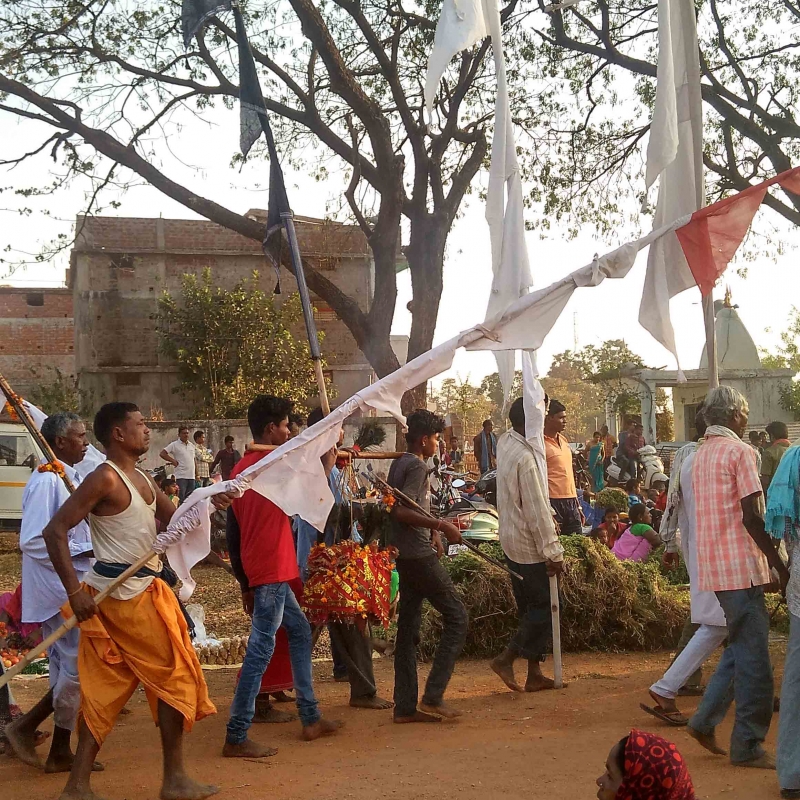The Gond adivasis are native to the states of Madhya Pradesh, Maharashtra, Orissa, Andhra Pradesh, Karnataka and Gujarat. In the wake of winter, as the harvest season comes to an end, an event of spiritual and cultural significance to the Gonds of Chhattisgarh is organized and celebrated across the villages and urban centres of Bastar. Pen Madai (as it is popularly known) is an event when members of various communities get together to organize and participate in an elaborate fair across the length and breadth of Chhattisgarh—a celebration that is complete with elaborate rituals, processions and fairs. Pen Madai (pen means deities) is not just any fair as Lakkhan Mandavi of Markabedha, Narayanpur, points out; rather, it is an event when the deities of different households and villages come together through pen jatras (processions with deities). Lakkhan says that a fair in the honour of ancestral and guardian deities is organized once a year; deities belonging to different villages are brought out to greet each other and to together enjoy the festivities of the fair. The fair, which is also known as pen mela or pen bazaar, is seen as an important event in the Gondi calendar of festivities across the regions of Bastar in India.
As one travels through Chhattisgarh during the last weeks of November, extending up to April, one experiences a palpable energy among the people. They would be stirring with excitement about the upcoming Madais (and melas) of various towns and villages. Yet, what sets the Madais of Bastar as categorically different is the nomadic nature of the fair. The Madai begins from Jagdalpur, and travels from one block to another. This means, care is taken that no two Madais are organized simultaneously. The first rounds of Madais begin in the months of November and December after the Raj Madai of Jagdalpur in southern Chhattisgarh. Raj Madai, as the name suggests, was started by the kings in the honour of the guardian deities of Bastar, and is celebrated along with the festival of Dussehra. This Madai sets the stage for the presence of all deities across the region. Brijlal Mandavi—the head priest of the village of Banoli (Baaskund panchayat, block Bhanupratappur)—elaborates, that the pens and dangs present in Raj Madai return to their respective villages after a month of festivities. He further stated that the visiting deities cannot leave without the permission of the guardian deity of Jagdalpur. After the culmination of festivities and celebrations, as the deities prepare to return, the sevaks (of these deities) in the village begin to be possessed by the divine power of the deity; this indicates the return of the ancestral gods and goddesses. It is then, that the Madais begin to get planned and organized across the villages and towns, travelling their way through the regions of Narayanpur, Antagarh, Bhanupratappur, Kondagaon, Keshkal, Bhopalpattanam and Dantewada, and culminating in the month of April at Geedam.
A Madai offers a site of an interesting confluence where spirituality meets merriment, culture meets commerce and trade, traditional rituals meet modern rituals of entertainment and local sweets and savouries meet urban fast food. One comes across Chhattisgarhi dance performances and talent shows, black magic shows, cock fighting contests, story-telling performances, circus acts and other stunt shows, rides of various kinds, and an extensive commerce of goods.
People coming to the fair have shared how the festival, which was celebrated essentially as a post-harvest spiritual event in villages, has today gained a new scale of grandeur, particularly when it is organized in towns and cities, such as Narayanpur, Geedam, Dantewada, Bhanupratappur, Kanker, Jagdalpur and Antagarh. One can experience the transition and transformation in the scale at which the Madai is organized, especially when one compares the experience of the fair organized at the level of the village and the ones organized in the urban centres. The change in scale can also be attributed to the fact that the state administration shares the responsibility to organize Madais in nagar municipalities that sees a huge crowd thronging the fair.
This piece seeks to highlight the nuances that make the Madai an important event in the lives of the people of Bastar. Beginning with the first day of elaborate rituals, I wish to walk the reader through the Madai, organized over a span of two to four days, and chronicling the important events of the fair as it travels from one location to the other.
Dancing with the Deities
A Gondi almanac is marked by many fairs and occasions where people of various communities come together. However, when one hears about Madai, post Dussehra, one realizes that the event that is being referred to is the pen Madai, that is celebrated after the kharif crop harvest. Madai in Gondi as an endemic term could translate into any form of social gathering. It can be thought to be similar to the sense conveyed by the term ‘mela’. One will thus find many renditions of such gatherings in the form of say Yuva Madais (events where youth gather, particularly for sport meets) and Didi Madais (events where women associated with state livelihood promotion schemes through self-help groups come together to congregate) across the region. One can find Madais being organized as melas or economic fairs across the region— Dantewada’s phagun Madai being such an example. Celebrated just a week before the event of Holi, Dantewada’s phagun Madai, similar to the pen Madais would begin after the ceremonial worship of the local deities. However, it stands as different from the pen Madais of our discussion since the fair is organized to mark the season of phagun (spring) and to help people prepare for Holi(a spring festival). However the pen Madai in Geedam, Dantewada, is organized at the end of the month of March and could at times stretch to the last week of April, to mark the culmination of the travelling fairs across Chhattisgarh. What then, makes the events of pen Madais different from that of other Madais and melas celebrated across Chhattisgarh?
Lakkhan Mandavi (of Narayanpur) points out that the purpose of the Madai is deeply spiritual; the act of parikrama with the deities that marks the inauguration of the fair sets the pen Madais of Bastar as distinct from other melas (or Madais) in the region. The first day is marked by ritual ceremonies performed by the sevaks (the shamans and the priests) assembled in a cleared space in the designated fair area. This is followed by a procession of deities to secure the well being of those who come to visit and trade in the fair. The procession circles the fair about three times. During the last round, the procession moves in the reverse direction, and the deities are then carried back to the deo sthal (place where the gods reside). The space is transformed into an area filled with spiritual energy, marked by the hypnotic rhythm produced by the beating of drums, where men dance and become possessed by the power of the deities.

Men carrying dangs during the procession
This ritualistic procession is, therefore, not only comprised of the deities; rather, it also incorporates men who feel the power of the deity flow through them. For a short while, they too become vessels of the ancestral deities, dancing to the rhythm of the gods. While the ceremonies are being performed and the pens (and dangs) are being worshipped and offerings are being made, one observes men who begin to sway back and forth, an indication that they are possessed. One should however be wary that the possession is not by evil spirits but rather by the deos (deities); the bodies of the men become mediums through which the deos communicate with mortals. This divine power is also the driving force that guides men who carry the pens and dangs. Many present at the site explain that it is the gods and goddesses (who reside in the pen and dang) who make the men move in a certain way. Pandit Ram Nareti (Durgkondal block, Uttar Bastar Kanker), who has been a carrier of the anga pen in his youth, shares his experience of how the phenomenon of dancing with the deos cannot be simply explained as merely dancing. It is as if the men and women (in certain parts where women are also allowed to carry the gods) for a certain amount of time have absolutely no control over how they move—rather, a certain force, which is believed to be of the gods and goddesses, assumes control of their bodies, making them sway and dance to the rhythms of the drums being played during the ceremony. This moment is considered an integral part of the event. People offer flowers to the men who are now vessels of the deities, and the procession proceeds through the fair.
The Madai celebrates a coming together of the divine and the human. In the village fairs, the deities are assembled around the time of noon; however, in urban centres, such as Narayanpur, Bhanuprattappur and Geedam, the deities begin arriving the night before, and continue to arrive from various villages till the following noon. Once all the deities have assembled in the deo sthal, the rituals begin with the continuous beating of drums. These ritual offerings can extend over a night, as was witnessed in Narayanpur, where the prayer rituals and the traditional dance began a night before the inauguration of the fair. The night was spent with young men and women (who often belong to the Gondi [traditional] institution of Ghotuls) dancing before the deities. For the dances, a larger area has to be cleared in the middle of the fair, where all the spectators join together to perform the karsaar while the priest performs the sacrifices and worship rituals. Once the offerings have been made, the pens and dangs been carried through the fair, and the gods have secured the fair through the ceremonial procession, the fair is declared open for the people.
One is told that the ritual of the Madais has existed through the centuries. As one looks into the anthropological studies of the adivasis, particularly the Gonds of central India, by eminent scholars, such as Verrier Elwin, Frederick Haimendorf and V.W. Grigson, one hardly finds references of this event. One of the earliest documentations of pen Madais as deoguri (deo - deity, guri – vehicle) jatra (procession or journey) or penkarsita among the Bastaria Gonds can be found in the works of Grigson (1938) in his documentation of the Maria Gonds of Bastar. Elaborating on the religious calendar of the Marias Gonds, Grigson compares the occasion of Madai, which he calls mandai to deoguri jatra and penkarsita (1938:220). He documents how the deoguri jatra which begins after poush kolang in the month of Magh, is the culmination of the ritualistic calendar of the Gonds.
However, there are Madais that are celebrated in the honour of a specific deo. In certain villages whose guardian deity is worshipped as pargana deo (an endemic term for a group of villages, whose number ranges from eight to ten to about twenty, which together make a pargana) there are fairs organized as dedications to one such deity. Here, one would see a larger number of deities, brought from various villages, to pay their respect to the deo. One such event is the deo Madai of Semargaon where the presiding deity—Kapar Lingo Deo baba (who is one of the supreme deities for Gonds)—sees about hundreds of pens brought together for the deo jatra. A two-day event, it sees people come together to offer prayers to the pens and dangs brought from various villages across Bastar. The event involves a night- long dance where people perform traditional dances to rela songs while carrying their gods, an event which Grigson (1938) has documented as penkarsita. Such dances are also referred to as pen karsaars, where the carriers of the pens and dangs are driven by the divine power of the ancestral deities and every one present at the ceremony dances with each other along with the gods. Only after pen karsita has been performed, and worship ceremonies have been offered, can the deoguri or procession through the fair begin.
Although the landscape of the event has evolved over the years, the deo or doeguri jatra still remains an imminent feature of the event. Deoguri iatra, as the name suggests, involves carrying and dancing with the deos embodied in pens and dangs. Pens are a framework of three or four parallel saja (Terminalia tormentosa) logs , selected from the forest (Tiwari 2015).
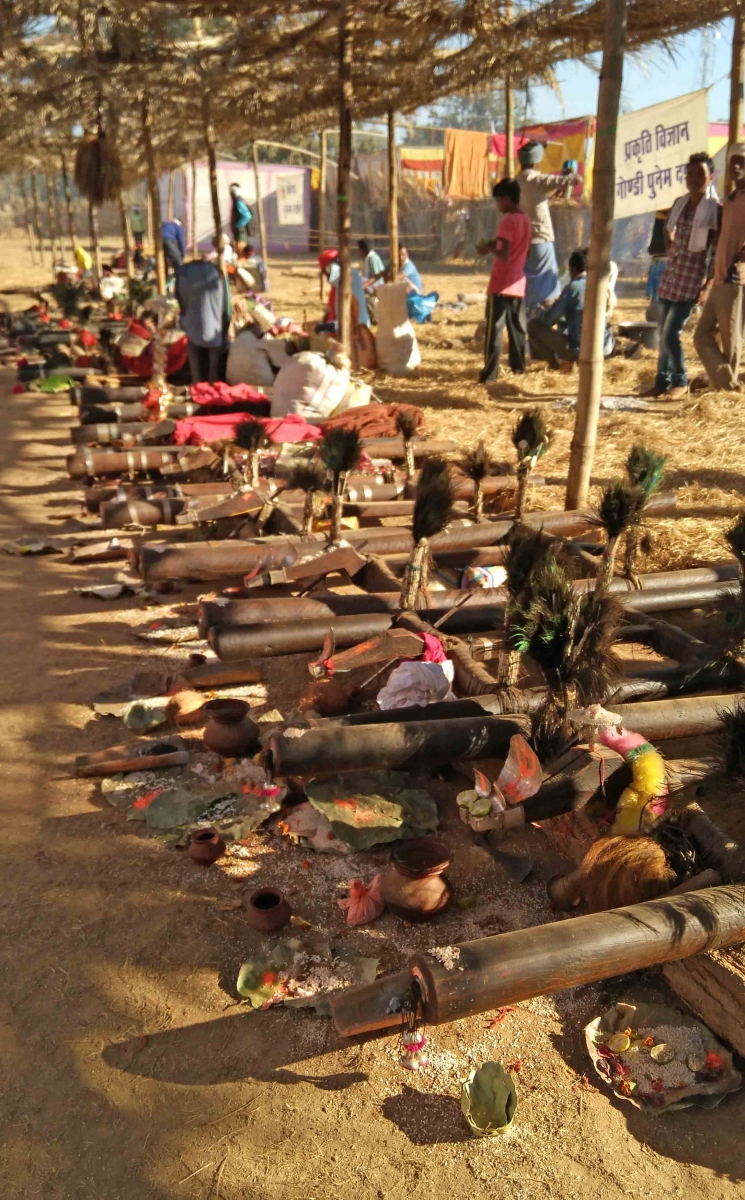
Pens at deosthal
It is believed that the ancestors continue to live and guide the Gondi clans through these pens after ceremonial rituals have been performed to render these logs as vessels containing the divine energy of the ancestral deities. Dangs are single pieces of long wooden logs with triangular flags of red or white color, tied at the upper end, with ghunghroos (bells) tied at the lower end. These log-gods are symbolic of the ancestral spirits with each clan having their own pens. It is believed that the pens represent the original ancestors of each clan. Thus in a village, one finds pens for every family and clan, where dangs represent the guardian deity—Jimmidaarin yaya—who is responsible for the safety and well-being of the people in the village, protects them from various calamities and presides over all the ritual and cultural ceremonies in the village. The guardian deity is also believed to ward off the evil and menacing spirits away from the village and its people, and is thus invoked in times of need by the people of the village (irrespective of their jati or religious affiliations).
As discussed above, the deo jatra involves bringing the ‘anga’ pens and dangs of the guardian deities together in an open space in midst of the flowers and mahua leaves, where gods meet and greet each other, and where men and women dance with their gods. Madai, as an event, begins with offerings of flowers, rice and vermillion, made to the guardian deities and pens (of various clans) invited from neighbouring villages. Among residents of the village, the non-adivasis too begin every occasion first by worshipping the guardian deity of the village and then their own religious gods and goddesses.
The Madai, although centered around the deities of the Gonds, is not limited only to the people of the Gond communities; rather, the rituals of the first day are incomplete without the participation of the members of other adivasi groups. Pandit Ram Nareti shares during a conversation that without the participation of other groups—the drums which are played by the people of the Gadha community, the flowers grown by the Maraars, the liquor brewed by the Kalhaars—the ritual ceremonies remain unfulfilled. Thus, one witnesses the coming together of various communities in various capacities in the deo sthal.
With time, the event of the Madai has seen a larger participation of other groups too, particularly that of the non-adivasis. Radheram Mandavi, a prominent village elder from Parvi, block Bhanupratappur (Uttar Bastar Kanker), elaborates how even though Madai was ritually always seen as a Gond festival, over the years not only adivasi, but also non-adivasi groups have joined in with their respective deities. Thus, from a time when only Gonds were responsible for organizing the event, today, many different ethnic groups join in to collectively organize the event both at the level of the village and at the urban centres. Thus the Madai organizing committee involves the participation of the village elders of all the communities present in the village. However, the decisions pertaining to scheduling of the date of the Madai still lies with the Gond priest in the village. Since most villages are inhabited by the Gonds, often the priest of the guardian deity (who has been chosen by the deity herself and belongs to the Gond community), after consultation with the deities and ancestral gods of the village, can declare the date to the members of the deo committee. Thus begins the preparations of the Madai—collection of donation, invites to the deities of neighbouring villages, booking of various performance troupes, booking of tents for stalls and shops of various kinds, invitation to traders to put up their stalls during the fair. These arrangements often span across months; thus the planning and preparations begin right after Dusshera, when the Madais begin to be scheduled after the Raj Madai of Jagdalpur.
Cultural significance
The festival of Madai also marks the beginning of the season of wedding ceremonies and rituals among the people of Bastar. It is during the season of Madais that families visit each other and alliances are made. Phaldaan—a ceremony that marks the agreement of the nuptial alliance between the families—is performed during this season when families visit each other in the Madais being organized around the region.
As people of various communities and regions come together and visits are made to various Madais, this offers an opportunity for families to scout and arrange for suitable alliances for their sons and daughters. It is said that the weddings that take place outside this season are usually the cases where the couple has either eloped or married against the wish of their families.
Besides the celebration of the harvest at the end of the monsoon, Madais also mean seeking the blessings of the deities prior to preparation for weddings and for the nuptial ceremonies. Thus, one sees that the traders who come to Madais also offer commodities that are an essential part of the wedding ceremony. And this ritual of the traders bringing in goods in large quantities and varieties has been an integral feature of the Madai for centuries.

Millets for sale and purchase by traders and vendors
Pandit Ram Nareti, (Durgkondal block, district Uttar Bastar Kanker) elaborated on how the pen Madais in Bastar came to be known as travelling fairs. He shares that before the advent of the modern modes of transportation, the traders would travel on bullock carts from one place to another. Thus, bookings were made in advance, and the fair would travel from one village to another according to the dates of the bookings. People would often wait all year for these travelling caravan of traders and merchants to make purchases of salt and spices, clothes and jewellery, until the next Madai. However, today with faster modes of transportation and growing commercialization, people are able to find many such occasions where the traders offer opportunities to make purchases for various events during the year. The enthusiasm and excitement for pen Madais have simmered but it has not been completely lost.
The fair offers stalls that sell metal suitcases, utensils of various kinds, clothes at wholesale rates (to be gifted to relatives and village members by the family of the bride and groom), silver jewellery and accessories of all kinds for women.
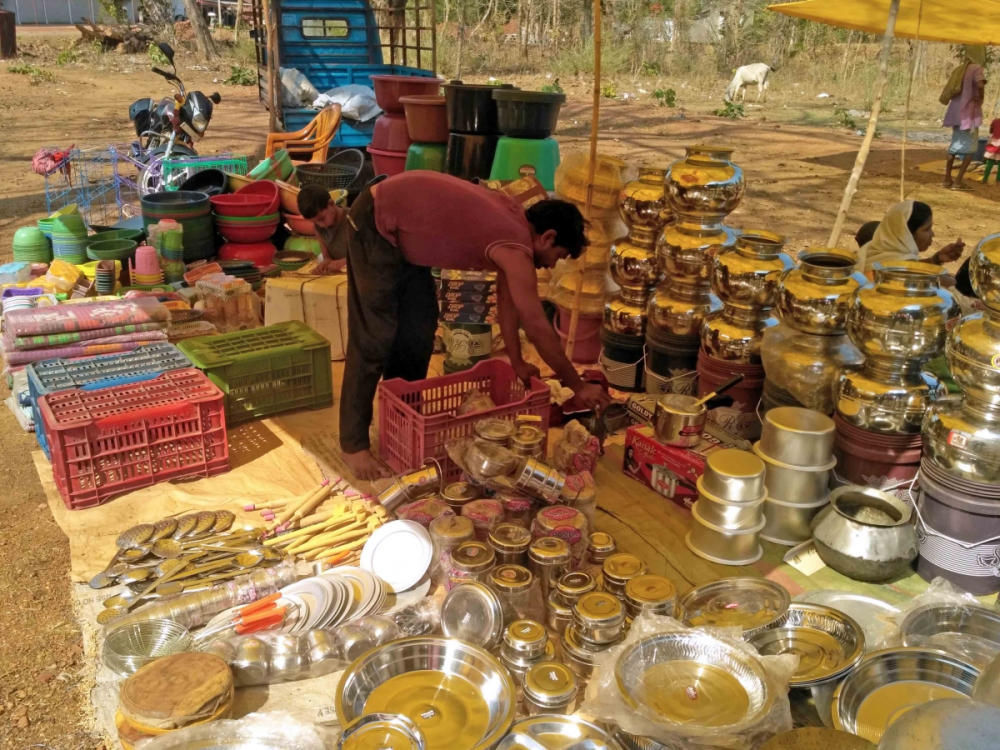
Utensils for sale during Madai
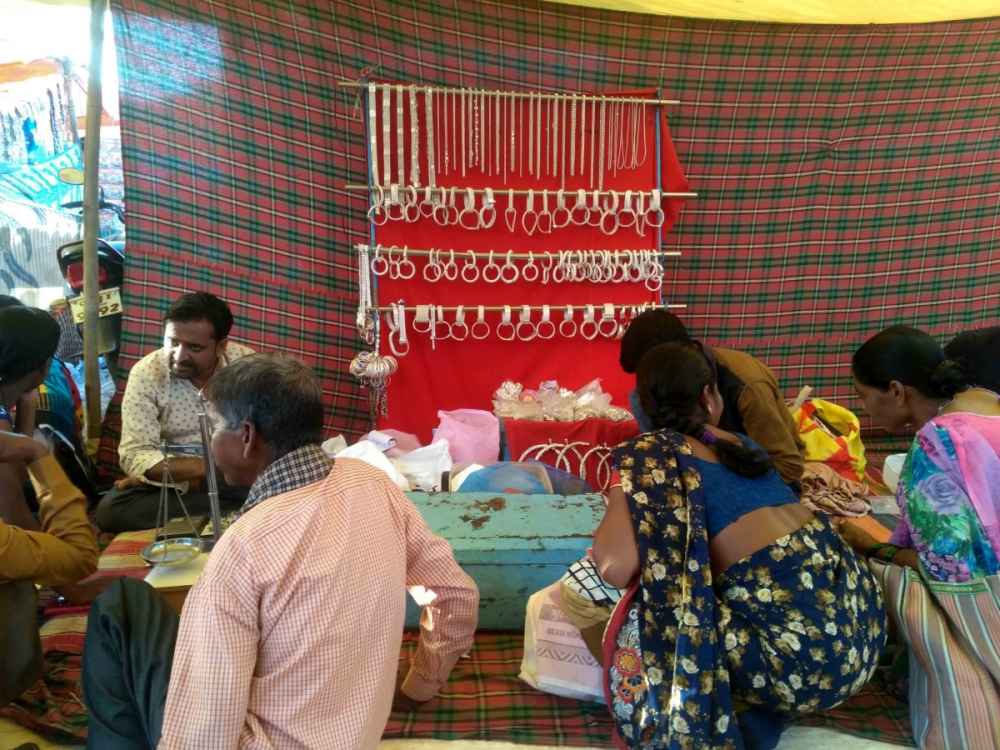
Silver jewellery being bought for marriage ceremonies
There is also a separate section devoted to vegetables and meats of all kinds. One also sees traders present in the market, who are willing to buy agricultural produce and non-timber forest products brought by the people to the Madai. After selling their produce, the people then use the same money to make purchases of various kinds as preparation for wedding ceremonies.
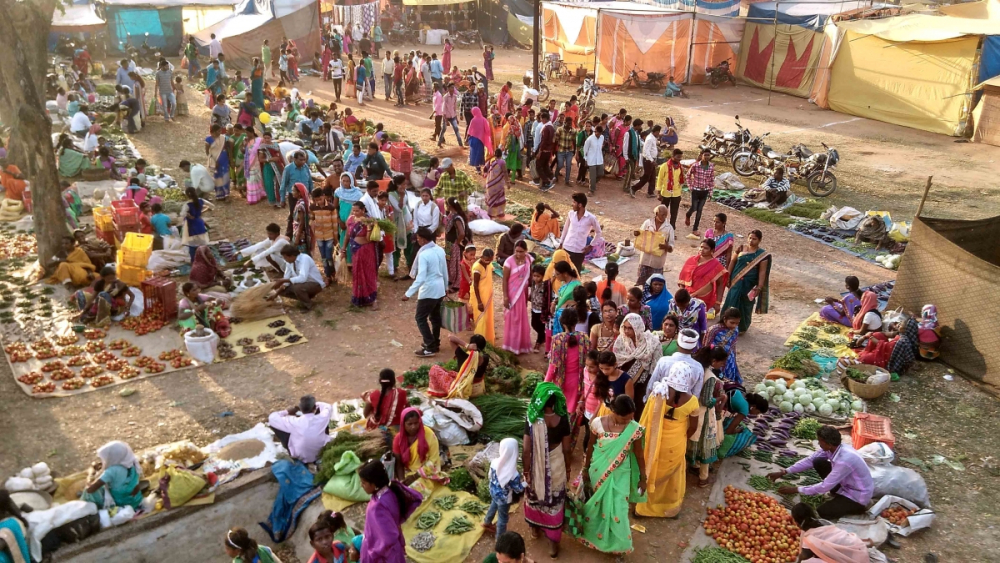
People buying and selling vegetables
Madai therefore offers a site of commerce and trade, where one often finds women and men selling various handicrafts and produce from their fields—ranging from millets to fresh vegetables and fruits, from baskets and brooms to elaborate decorative items, all produced at home. Besides these, one also comes across innumerable shops of sugar-based sweets and savouries, kiosks offering soft drinks and ice creams, stalls that sell cosmetics, women’s accessories and apparels in addition to the endless number of vendors of bangles and anklets. Depending upon the location of the Madai, the grandeur of the vendors and their products varies with the geographical location of the venue. For instance, bigger Madais of urban centres sees stalls that even sell farming equipments, tractors, seeds and fertilizers. One also comes across stalls with greater variety in accessories for women.
From cockfights to joy rides and dance troupes
Among the many attractions of the Madai, one that attracts the largest number of people, particularly the youth is the segment of entertainment. Crowds throng the stalls that offer entertainment in the form of dance troupes, musical performances, circus acts, magic shows and rides of various kinds varying in the degree of recklessness and adventure, stunt shows such as, the well of death, cockfighting pits, performances by local nacha parties and jatras, chronicling the myths revolving around the guardian deities, gods and goddesses of the village.
After the culmination of the ritual ceremonies on the first day, one finds groups of men securely carrying their roosters and moving to a cleared space. As one follows them, one arrives at a clearing where a fighting pit has been created, with enthusiasts crowded around owners who are seeking worthy opponents for their champion. The scene is complete with experts with their kits full of small sharp knives, waiting to prepare the cockerel for the fight. Organizers incessantly make announcements about the fights in the pit, ready to take the bets. One can hear the enthusiasm of the fighting ring from a distance.
After the day has been spent in the fair, one event to look forward to, is the performances by nacha parties who often perform for an entire night for the people who have come to the village Madai. Nacha parties have been an integral part of Madai festivities since the time electronic sources of entertainment had still not invaded the rural households. Then, the people would wait for for an entire year for the Madais and the night full of musical theatre performances by local musical theatre groups. Today, the nacha parties have given way to a modern-day version of stage performances where the performers perform to popular Bollywood and Chhattisgarhi numbers. While the rural nacha party performances were marked by compositions and scripts by the artists themselves with a live band accompanying the performers, the modern-day dance troupes and talent shows focus more on appealing to the popular demand of the youth, and it seems as if folklore has lost out to item numbers. However, the tradition of the nacha parties still continue in the Madais organized at village levels. People still wait for the performances scripted by the members of the troupe. The theatrical performances, complete with navarasas, enthrall their spectators through the night. While one can still come across indigenous groups who continue with the tradition of chronicling the local folklore or make presentations with social messages, the urban centres or bigger Madais see a very different form of entertainment when compared with local theatre parties.
These dance troupes, complete with live music and dance shows, become a source of attraction for the youth among the crowd. Rather, it seems that the entertainment segment is created to cater to the fantasies and desires of the younger generation that visits the Madai. The joy rides, various kinds of stunt shows, circus shows, black magic shows, the fast food corners, the stalls of cotton candies, ice creams, sodas, soft drinks, electronic devices and accessories, are all designed to attract crowds to this glittery part of the fair. As the sun sets, the numbers flocking to this section also increases. The loud music and incessant announcements along with bright flourescent lights, all draw the attention of the young fair goers. In contrast to the nacha parties of the village, the dance troupes of the city Madais offer a different palette of entertainment. Although it may seem from the outset that the dance parties cater to a specific gender— particularly the men—these shows should not be thought to be limited to the male audience. The spectator area is separated according to gender which also allows women to enjoy these performances. The performing artists entertain their audiences with popular dance numbers, from Chhattisgarhi to Bollywood item songs, and at times artists also perform to live orchestra.
This segment of the Madai—its bright and dazzling florescent lights, wooden swings (when organized in villages) and motor powered fast rides in towns, performances ranging from feisty Bollywood numbers to the narration of folk-lore and night-long performances based on everyday issues of violence, discrimination and inequality by the nacha party, cock fights and daring stunts of fast driving in the narrow walls of a wooden well, candies, ice-creams sodas—makes it a space where rituals are embedded in the ancestral traditions in forms of entertainment borne by modernity. Thus, Madai presents an interesting co-existence of modernity and traditional festivities where culture meets trade; the Madai has something to offer to everyone, and all of it is brought together within a span of a few days.
Conclusion
Madai as a space can also be seen as a microcosm of how the adivasi and non-adivasis communities come to co-exist in a space that is predominantly Gond. Even though Madai in essence, is a festival of Gond deities, yet it remains incomplete without the presence and contribution of other non-Gondi communities. The ritual remains incomplete unless there are members from the Gadha community playing the percussions, the offering ceremonies will remain unfulfilled without the flowers grown by the Maraars, even the weddings will not be considered auspicious unless the Maur (a veil prepared from the tender stems of the palm tree worn by the groom) is prepared by the hands of a Maraar, the ceremony cannot begin without the cloth, which is offered to the deities, is woven by the Kosth community and without the brews of the Kalhaars, the devi will not accept the prayers. Pandit Nareti explains that without the participation of the different communities, the Madai as an event would remain incomplete. He adds that one can witness the existence of hierarchies between these groups till the present day; but, traditionally speaking without the co-existence of these groups, many of the Gond rituals and ceremonies cannot be performed.
Thus Madai sees a coming together of not only gods but also people from afar. The event becomes an opportunity to visit relatives and friends from various regions. The second day of the madai is dedicated to honouring the visiting guests. People of the host village find themselves engrossed in hosting friends, family, relatives and even acquaintances from various villages who visit the Madai. Further the festival also offers an opportunity to young men and women to meet each other. Offering and acceptance of paan (betel leaves) can often translate into an expression and reciprocation of affection and liking among the youth. Men and women dress for the occasion and glances are exchanged during the fair, the rides and even during the karsaar.
The Madai is not just a travelling fair, rather it is an occasion of festivities—a celebration of coming together. Madai becomes an occasion where relationships are either created or renewed not only between the deities, but also between mortals who meet and greet each other across regions and communities, and between the human and the divine.
References
Sen, Abha. No date. ‘Madai mela:Jaha raja-maharaja bhi karte the shirkat'. Online at https://www.patrika.com/bhopal-news/madai-fairs-of-madhya-pradesh-3889/ (viewed on April 1, 2018).
Grigson, W.V. 1938. The Maria Gonds of Bastar. London : Oxford University Press.
Tiwari, Sonal. 2015. 'Ecological Sustenance of Vernacular Settlements: A case of Baiga tribal settlement in Amarkantak, in Madhya Pradesh, in India'. (Retrieved from Research gate on April 4, 2018)
External Links
The following links are to the web pages of travel operators who offer brief descriptions of the event of the Madais. The web sites were accessed from March 14–17, 2018.
https://www.indianholiday.com/fairs-and-festivals/chhattisgarh/madai-festival.html
http://travelthemes.in/madai-festival-of-chhattisgarh/
https://htoindia.com/blog/madai-festival-tribal-event-full-fun-joy/
http://www.onlytravelguide.com/madhya-pradesh/fairs-festivals/madai-fair.php
